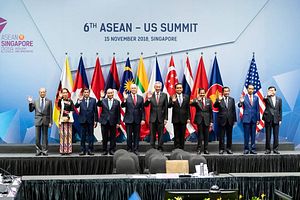Going into last week’s ASEAN summitry in Singapore there were hopes that some progress would be made on the U.S.-China-ASEAN complex of disputes in the South China Sea. But the summits have come and gone and, if anything, the situation in the South China Sea is more complicated than before. Although the contentiousness of the disputes between China and ASEAN claimants has waned, the U.S.-China rivalry for dominance has supplanted them as the preeminent security issue for ASEAN and the region. Indeed, ASEAN-China political relations, and in particular their negotiations on a Code of Conduct for the South China Sea (COC), are now conflated with — and will be strongly influenced by — the U.S.-China rivalry.
In the months preceding the summits, the United States and China had already stepped up their contest of words and actions.
Then the long-anticipated second U.S.-China Diplomatic and Security Dialogue, held on November 9, came and went with no apparent progress on any of the dangerous issues between them – especially their confrontation in the South China Sea.
Observers in both countries had hoped that meeting would lead to some tension-lowering agreements or at least public statements from both to that effect. For example, Zhao Minghao, writing in the Global Times, said, “It is expected this dialogue will ease the rising tensions between Beijing and Washington, or at least pause the escalating Sino-U.S. friction.” Randall Schriver, a top Pentagon official for Asia, said the talks would include “’risk reduction’ efforts that the two countries can undertake, which aim to drive down the chance of an inadvertent clash,” in Reuter’s paraphrasing. However, in actuality, the two delegations mainly talked past each other, bluntly restating their sharply opposing positions. Tensions remained high.
Hopes for an improved South China Sea situation via the ASEAN summits were dashed even before the meetings began. On his way to Singapore, U.S. Vice President Mike Pence called out China, saying that if it wants to avoid an all-out cold war with the United States, it must change its behavior. When he arrived in Southeast Asia, he told the ASEAN leaders that “empire and aggression have no place in the Indo-Pacific,” presumably a warning to China.
Coincident with Pence’s attendance at the Summits, the U.S. Navy carried out dual aircraft carrier operations to the east of the Philippines. This was both a show of force that backed up the U.S. commitment to a “free and open Indo-Pacific” and a demonstration that “the U.S. Navy will fly, sail and operate anywhere international law allows.”
On the sidelines of the summits, U.S. National Security Advisor John Bolton made it clear that the United States is preparing to build up its forces in the region and in particular its patrols in the South China Sea.
Earlier, there had been some hope — as well as hype — that the ASEAN-China agreement on a Single Draft Negotiating Text (SDNT) for a Code of Conduct (CoC) was a sign of progress. But then it was revealed that new very contentious issues had been added to the draft. China has proposed a clause stating that “the parties shall not hold joint military exercises with countries from outside the region, unless the parties concerned are notified beforehand and express no objection.” Agreement to this proposed clause would gravely damage the alliances and relations of Thailand and the Philippines with the United States. China has also proposed that economic activities in the disputed region “shall not be conducted in cooperation with companies from countries outside the region.”
In a clear rebuke to these proposals the United States, Australia, and Japan issued a joint statement calling for the CoC:
[to be] consistent with existing international law, as reflected in UNCLOS; to not prejudice the interests of third parties or the rights of all states under international law; to reinforce existing regional architecture; and to strengthen parties’ commitments to cease actions that would complicate or escalate disputes.
From Singapore, Bolton warned that, as the Wall Street Journal put it, “the U.S. would oppose any agreements between China and other claimants that limit free passage to international shipping and that American naval vessels would continue to sail through these waters.”
Bolton elaborated that any CoC “has to be acceptable to all countries that have legitimate maritime and naval rights to transit and other associated rights that we don’t want to see infringed.” That left no doubt that the United States was “all in” regarding the China-ASEAN COC negotiations — and in making this public may have doomed them as well. Meanwhile Chinese Premier Li Keqiang insisted that “China would play a major role in writing” the CoC.
Now it is crystal clear that the U.S.-China rivalry will have a major influence on the negotiations. China has previously said that the pace of the CoC negotiations may depend in good part on whether or not Beijing perceives that the United States is “meddling” in them. Although Washington probably was making its preference known behind the scenes, what is new is that it now is publicly doing so.
The pressure from the two great powers is becoming increasingly uncomfortable for ASEAN members. The host of the ASEAN Singapore summits, Prime Minister Lee Hsien Loong, said that the U.S.-China rivalry is putting regional countries in an “awkward” position, telling reporters, “[I]f you are friends with two countries which are on different sides, then sometimes it is possible to get along with both, sometimes it’s more awkward if you try to get along with both.”
Southeast Asian countries had better prepare, because the pressure to “take sides” shows no sign of ameliorating. Indeed, it is intensifying and ASEAN unity and centrality in regional security are clearly being eroded. The South China Sea situation and its impact on Southeast Asian security is likely to get worse before it gets better – if it ever does.
Mark J. Valencia is Senior Adjunct Scholar at the National Institute for South China Sea Studies in Haikou, China.
































